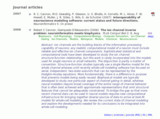Research Impact
|
Is your publications list:

|
PublicationsList.org makes it simple for you to set up and maintain a professional web page listing your publications with links to online full text versions (PDF / HTML), abstracts, import and export to standard citation file formats such as bibtex, EndNote, Reference Manager, Web of Science, and auto-import from the PubMed database for biomedical researchers. Launched in 2007, the service is now used by over 24,000 researchers from many universities, research organisations and companies worldwide.
"Excellent idea, an important tool especially for new scientists and researchers. Congratulations!"
People are more likely to cite your work if they can find and read the full text of your articles and copy / paste the citation details without wasting time searching. Click on the names of researchers below who have recently listed their publications to see sample pages, or find out more.
|
|
|
Use the form below to sign up and create your FREE online publications list page now:
The standard version is FREE for individual researchers


|
||
|
What is the impact of a journal? |
The impact of a journal is the number of times an average article in the journal is cited per year, averaged over the previous two years as follows:-
A = the number of times articles published in
2004-5 were cited in indexed journals during 2006
B = the number of articles, reviews, proceedings
or notes published in 2004-5
2006 journal impact = A/B
The measurement is in widespread use for assessing journal quality, but has its flaws and biases - e.g. all citations are weighted equally [even negative citations - if paper X cites paper Y as containing errors, the citation actually improves the research impact of the journal Y appeared in], only citations from journals in the ISI index are included. Nature and Science have research impacts approx 30, a very high impact journal in the range 10 - 15 (e.g. PLoS Biology), with specialised journals typically in the range 0.5 - 4. Other measurements of journal and paper impact include applying variants of the Pagerank algorithm used by Google, with citations weighted by the impact of the source journal or citation count of the citing article. Researchers are increasingly being measured by the impact of their research, currently often using crude measures such as the research impacts of the journals they publish in, but also by more relevant measures such as individual citation counts. The H Index or Hirsch Number is another measure of researcher productivity - A scientist has index h if h of his/her Np papers have at least h citations each, and the other (Np - h) papers have no more than h citations each. (see J.E. Hirsch (2005) [PDF]) |
|
|
Can our research group / department use publicationslist.org to maintain the group's publications lists? |
Research groups, departments and institutions are increasingly having to justify their research output and impact to funding bodies, and many research councils are starting to require that all the work they fund is freely available in full text on the web by self-archiving on department websites or institutional preprint repositories. Getting faculty members to enter their publication details in order to keep the department website up to date can be hard work however. Publicationslist.org makes it much simpler by presenting an easy to use web based user interface which each faculty member can use to enter their publications details for their personal page and also for integration into the departmental website. Individual publications can be tagged with keywords which can then be used to select particular publications for research assessment reports or other purposes. |

